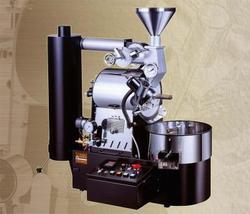Afterburner system of coffee roaster burner gas supply system diagram of coffee roaster knowledge of coffee roaster
Post-burner system, also known as direct-fired thermal oxidizer system.
Direct-fired thermal oxidizer or post-burner is the simplest kind of thermal oxidizer, which can greatly reduce VOC emissions by instantly cremating soot or carbide ions into clean water vapor at a high temperature of about 500C.
This kind of thermal oxidizer does not carry any heat recovery equipment and cannot recycle the heat generated in the combustion process. Typical direct-fired thermal oxidizer systems usually include burners, combustion chambers, fans, air / fuel control assemblies, thermal instruments and automatic control systems, and chimneys.
Generally speaking, direct-fired thermal oxidizers have less investment than other types of thermal oxidizers. However, when this kind of thermal oxidizer is used to treat endothermic waste fluid, the operating cost (fuel consumption) is relatively high. for example, the gas consumption of coffee roaster with "post-burner" is more than three times that of baking itself before installation.
The "post-burner system" in aerospace dynamics is a completely different concept.
VOC (volatile organic compound)-definition
The American ASTM D3960-98 standard defines VOC as any organic compound that can participate in atmospheric photochemical reactions. The Federal Environmental Protection Agency (EPA) defines volatile organic compounds as any carbon compounds that participate in atmospheric photochemical reactions except CO, CO2, H2CO3, metal carbides, metal carbonates and ammonium carbonate.
The World Health Organization (WHO,1989) defines total volatile organic compounds (TVOC) as volatile organic compounds whose melting point is lower than room temperature and boiling point is between 50 and 260 ℃.

Source:
Huang Wei's blog of roasting boutique coffee
Important Notice :
前街咖啡 FrontStreet Coffee has moved to new addredd:
FrontStreet Coffee Address: 315,Donghua East Road,GuangZhou
Tel:020 38364473
- Prev

Roasting utensils and roasting process changes in the roasting process of brand coffee raw beans
Coffee roasted Coffee Roasting coffee is popular mainly because of the aroma formed after roasting and the taste when drinking. The coffee raw bean itself does not have any special taste, it is roasted to completely change and reorganize the substances inside the raw bean to form a new structure, thus bringing out the mellow flavor of the coffee. Baking tool roaster, divided into three types: direct fire type, semi-hot air straight
- Next

Cup Test of Columbia Rosa Coffee the annoying flavor characteristics and taste of the world's top coffee beans
Geisha is an Arabica coffee variety from Geisha Mountain in southwestern Ethiopia, which is transliterated as Rosa in China. Because the Japanese pronunciation of geisha is similar to Geisha, Geisha is called Geisha Coffee in Japan. I think it is easier to communicate with foreign countries in Chinese or transliteration. According to the website of Panamanian Jade Manor, Rosa Coffee is seeded in 1.
Related
- Beginners will see the "Coffee pull flower" guide!
- What is the difference between ice blog purified milk and ordinary milk coffee?
- Why is the Philippines the largest producer of crops in Liberia?
- For coffee extraction, should the fine powder be retained?
- How does extracted espresso fill pressed powder? How much strength does it take to press the powder?
- How to make jasmine cold extract coffee? Is the jasmine + latte good?
- Will this little toy really make the coffee taste better? How does Lily Drip affect coffee extraction?
- Will the action of slapping the filter cup also affect coffee extraction?
- What's the difference between powder-to-water ratio and powder-to-liquid ratio?
- What is the Ethiopian local species? What does it have to do with Heirloom native species?

